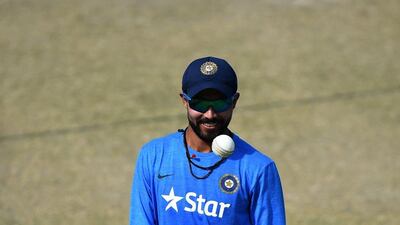When he came on to bowl the 13th over in Bangladesh's chase against India, Ravichandran Ashwin had two choices, the two choices any bowler has in such situations.
Shakib Al Hasan was out of the batting trough he had been in since the start of the year. In the previous over, despite losing the captain Mashrafe Mortaza, he had muscled Ravindra Jadeja over the midwicket boundary for a second six of the innings; it was beginning to look as if the fate of this chase was inextricably linked to Shakib’s.
Ashwin had bowled three good overs already. MS Dhoni went to him, he later said, because he had to: Ashwin is his best bowler, Bangladesh were getting close and he needed to get rid of what he saw as the main threat.
So Ashwin and the eternal two choices of all bowling, except that in Twenty20s each decision acquires a sharper edge: Bowl to keep the runs down and hope the pressure he builds pays dividends later? Or bowl to take a wicket but maybe concede runs in the process?
Speaking post-match to the broadcaster Ashwin said that whenever he is confused by such choices, he chooses the latter option. So he bowled his first ball slower, a little loopier and dragged Shakib forward a little outside his off-stump.
Read more: Spin City in India – How the World Twenty20 Super 10 sides have employed their spinners
Also see: Virat Kohli powers India over Australia into World T20 semi-finals – in pictures
Except Shakib could not get forward enough, the ball broke away, caught the edge of a defensive push and Dhoni, knowing he needed this wicket, had a slip in place. It was the kind of spinner’s dismissal you could enact in any format.
Ashwin ripped the ball through that over, conceding just one run, off the last ball. Jasprit Bumrah bowled two outstanding overs at the death but without this from Ashwin, this over of attacking spin, who can say how the match might have gone?
We are, this World Twenty20 is showing us, in a new age for spin bowling. It applies across all formats but is felt especially in the shortest. The previous age ended with the International Cricket Council's (ICC) clampdown on the bowling actions of the modern breed of off-spinner: Saeed Ajmal, Sunil Narine, Mohammad Hafeez, Sachithra Senanayake and others. Each of them had done especially well in the format; Ajmal is the third-highest wicket-taker in Twenty20 internationals.
The top six wicket-takers at this World Twenty20 are spinners, but of all shades. Mohammed Nabi, of Afghanistan, is at the top, bowling what you might call old-fashioned off-spin.
The two behind are a leg-spinner and a left-arm spinner: Afghanistan’s Rashid Khan and Shakib’s low-arm darts. Behind them is Bangladesh’s Mustafizur Rahman and another left-arm spinner, Mitchell Santner offering a smarter, more expansive repertoire than Shakib. Santner’s partner in their ride to the semi-finals, Ish Sodhi, serves up leg-spin.
New Zealand's reliance on, and use of, spinners has actually forged the path. For one, they are well stocked in spin, and Nathan McCullum as the third in the attack has often slipped under the radar.
To have three at the same time can be dismissed as a rare generational quirk for New Zealand, so much so that Tim Southee and Trent Boult have not played a single game so far.
But they have to be deployed properly too, and Kane Williamson has been deft and fresh in his handling of them. Sodhi, for instance, has bowled overs at the death regularly, totalling six after the 15th in four matches.
For all World Twenty20 updates: World Twenty20 latest news, scores and schedule in UAE time
Every time he has picked up one wicket and not just any: MS Dhoni, in the 17th over against India, Glenn Maxwell in the 16th against Australia and Shahid Afridi in the 16th against Pakistan. These are game-changing wickets.
McCullum has opened the bowling, which is standard fare. But Santner has been the floater in that triumvirate. He has usually begun within the Powerplay – and opened against Pakistan – but has then been used either to build up pressure on a batting order by bowling overs in succession, or disrupted their rhythm by bowling one-over spells. The former was perfect for Pakistan, the latter ideal for India.
“Cricket drools over little else as much as leg-spinners though and so, on surfaces invariably offering turn, it is no surprise that as many as seven feature in the top 31 wicket-takers. That is more than any other kind of spinner,” Steve Smith, the Australia captain said. Incidentally, even at the World Twenty20 2014 there were three leggies in the top five wicket-takers.
“They always have a little bit of variation,” Smith added. In Adam Zampa, Smith has a potent leggie of his own.
“If you miss the middle of the bat, you can quite often get a wicket. The ball doesn’t quite often clear the boundary. So you see a lot of wickets caught on the fence. I think the little bit of variation of the leg-spinner brings about those chances. They’ve done well traditionally in T20 cricket.
“I’ve been very proud of the way Adam Zampa has bowled for us, he bowled exceptionally well in the first two games and since the time he started playing for Australia.”
Before the tournament began it seemed as if this new age might be short on quality spinners, beyond India's attack. That was wrong. And certainly nobody could have predicted a scenario in which three of the four semi-finalists were non-Asian sides, and had – even England to an extent – to thank their spinners for it.
osamiuddin@thenational.ae
Follow us on Twitter @NatSportUAE
Like us on Facebook at facebook.com/TheNationalSport

